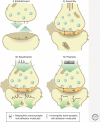Synaptic cell adhesion
- PMID: 22278667
- PMCID: PMC3312681
- DOI: 10.1101/cshperspect.a005694
Synaptic cell adhesion
Abstract
Chemical synapses are asymmetric intercellular junctions that mediate synaptic transmission. Synaptic junctions are organized by trans-synaptic cell adhesion molecules bridging the synaptic cleft. Synaptic cell adhesion molecules not only connect pre- and postsynaptic compartments, but also mediate trans-synaptic recognition and signaling processes that are essential for the establishment, specification, and plasticity of synapses. A growing number of synaptic cell adhesion molecules that include neurexins and neuroligins, Ig-domain proteins such as SynCAMs, receptor phosphotyrosine kinases and phosphatases, and several leucine-rich repeat proteins have been identified. These synaptic cell adhesion molecules use characteristic extracellular domains to perform complementary roles in organizing synaptic junctions that are only now being revealed. The importance of synaptic cell adhesion molecules for brain function is highlighted by recent findings implicating several such molecules, notably neurexins and neuroligins, in schizophrenia and autism.
Figures




References
-
- Akins MR, Biederer T 2006. Cell–cell interactions in synaptogenesis. Curr Opin Neurobiol 16: 83–89 - PubMed
-
- Ango F, di Cristo G, Higashiyama H, Bennett V, Wu P, Huang ZJ 2004. Ankyrin-based subcellular gradient of neurofascin, an immunoglobulin family protein, directs GABAergic innervation at purkinje axon initial segment. Cell 119: 257–272 - PubMed
-
- Araç D, Boucard AA, Özkan E, Strop P, Newell E, Südhof TC, Brunger AT 2007. Structures of Neuroligin-1 and the Neuroligin-1/Neurexin-1β complex reveal specific protein-protein and protein-Ca2+ interactions. Neuron 56: 992–1003 - PubMed
Publication types
MeSH terms
Substances
Grants and funding
LinkOut - more resources
Full Text Sources
Other Literature Sources
